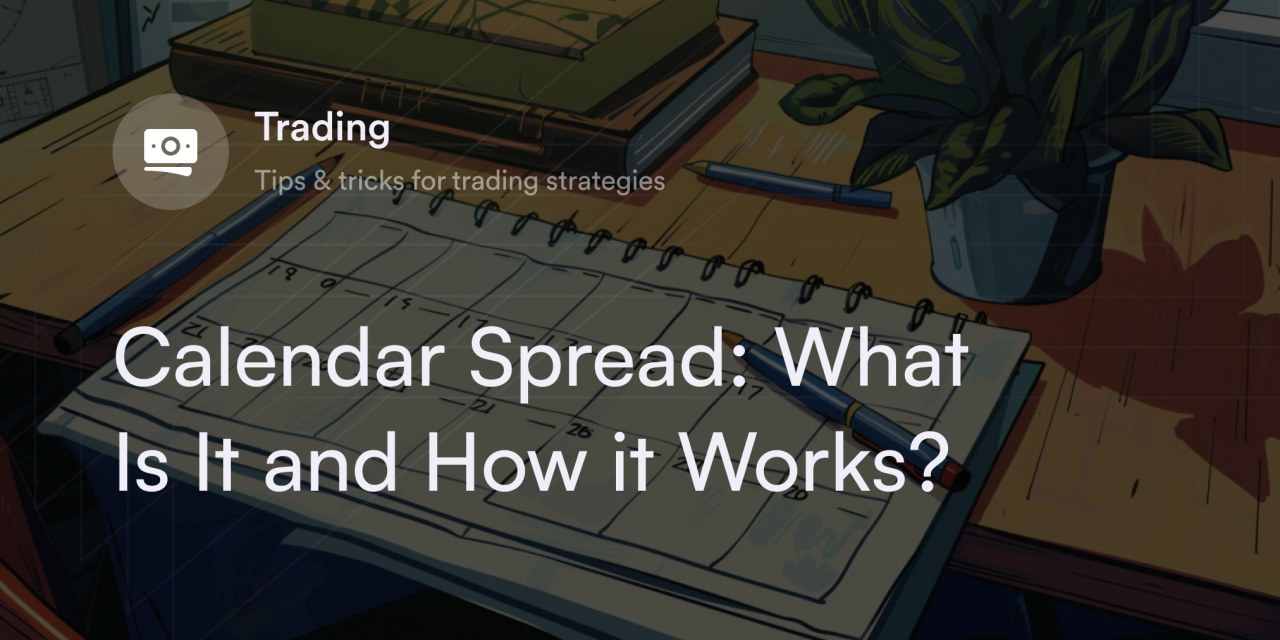


Many professional sports bettors place their money on both teams to ensure they win something regardless of the outcome. This strategy is also applicable in the financial space, allowing traders to make profits regardless of price movement.
But what makes this possible? Enter calendar spread, a finance technique involving traders betting twice on the same asset to boost their profit-earning potential.
In this guide, we’ll discuss calendar spread options, including what these mean, how these work, and the examples of calendar spread. We’ll also review the two types of spread options and explain the meaning of a calendar call.
What is a calendar spread?
A calendar spread, also known as a horizontal spread or time spread, is a strategy used in options trading. It involves the simultaneous purchase and sale of two options of the same type (either two calls or two puts) and strike price but with different expiration dates. This strategy is typically employed when a trader expects minimal movement in the underlying asset's price in the short term but anticipates more significant price fluctuations in the long term. The process allows a trader to be neutral on the investment and garner profit regardless of whether the asset is bearish or bullish.
There are two primary types of calendar spreads:
Calendar call spread
In a calendar call spread, a trader buys a long-term call option and sells a short-term one with the same strike price. The goal is to profit from the faster time decay of the short-term option.
As time passes, if the underlying asset's price remains near the strike price, the short-term call option will lose value faster than the long-term call option. The ideal scenario is for the short-term option to expire worthless or be repurchased at a lower price while the long-term option retains significant time value.
The maximum profit in this strategy is generally limited and occurs if the underlying asset is at or near the strike price at the expiration of the short-term option. The maximum loss is the net premium paid for the spread if the underlying asset moves significantly away from the strike price, causing both options to lose value.
Calendar put spread
A calendar put spread involves buying a long-term put option and selling a short-term put option, again with the same strike price. This strategy is usually applied when the trader believes the underlying asset will remain stable or decrease slightly in the short term, with a more significant potential drop in the longer term.
The mechanics are similar to the calendar call spread, with the key difference being put options. The trader benefits from the faster time decay of the short-term put than the long-term put. The ideal situation is for the short-term put to expire worthless or lose much of its value while the long-term put retains more of its value.
The maximum profit for this strategy is usually limited and occurs if the underlying asset is at or near the strike price at the expiration of the short-term option. The maximum risk is the initial cost of the spread, which occurs if the underlying asset moves significantly in either direction, leading to a loss in value of both put options.
How does the calendar spread strategy work in options trading?
The calendar spread strategy in options trading is a market-neutral approach that capitalizes on differences in time decay and volatility between options with the same strike price but different expiration dates. It typically involves two key steps:
1. Selling a short-term option
Here, the trader sells an option (call or put) with a near-term expiration date. This option is sold at the same strike price the trader plans to buy the longer-term option. The idea behind selling the short-term option is to benefit from the rapid time decay that options experience as they approach their expiration date, especially for at-the-money (ATM) or near-the-money (NTM) options. The premium received from selling this option provides immediate income and helps finance the purchase of the longer-term option.
2. Buying a long-term option
Simultaneously, the trader buys an option of the same type (call or put) at the same strike price as the one sold but with a longer expiration date. The longer-term option has a slower rate of time decay than the short-term option, which is a crucial aspect of the strategy. The goal here is for the long-term option to retain a significant portion of its value, even as the short-term option loses value more rapidly.
Examples of calendar spread
To illustrate how a trading calendar works, let's go through a few examples, including a long call calendar spread, a long put calendar spread, and a short calendar spread with calls and puts.
Long call calendar spread
Suppose an asset trades at $50. A trader believes the asset will stay near this price in the short term but might increase in the long term.
The trader executes a long call calendar spread by selling a 1-month call option with a $50 strike price for a premium of $2 and buying a 3-month call option with the same $50 strike price for a premium of $4.
The net cost to enter this spread is $2 ($4 paid - $2 received).
Ideally, the asset price stays around $50 until the near-term call expires. The trader keeps the $2 premium from the short call, still holding the long call, which retains value due to its duration.
If the stock price rises significantly after the short call expires, the trader can profit from the long call option.
Long put calendar spread
An asset trades at $100, and a trader predicts the stock price won’t change much in the near term but may drop later.
The trader initiates a long put calendar spread by selling a 1-month put option with a $100 strike price for $3 and buying a 3-month put option with the same $100 strike price for $6.
The initial investment is $3 ($6 paid - $3 received).
The goal is for the stock to be close to $100 at the expiration of the short put, so it expires worthless, and the trader retains the premium. The long put still holds value and can benefit if the stock price declines later.
If the stock drops significantly after the short put expires, the long put becomes profitable.
Short calendar spread with calls and puts
This is a less common variant where the trader expects a significant move in the underlying asset's price but is unsure of the direction.
For example, an asset is worth $75. The trader sells a 3-month call and put, both with a $75 strike price, receiving a total premium of $10. Simultaneously, the trader buys a 6-month call and put, also at a $75 strike price, for a total cost of $14.
The net outlay is $4 ($14 paid - $10 received).
The trader profits if the stock makes a significant move in either direction, making the long call or put valuable, while the short options lose value over time.
This strategy is riskier as it involves short positions in both calls and puts, exposing the trader to potentially unlimited losses if the stock makes a substantial move in the wrong direction.
Become a crypto pro with dYdX Academy
Looking to upgrade your crypto knowledge? Head to dYdX Academy, our education hub that includes simple guides on all things blockchain. dYdX also gives eligible traders access to our premier decentralized exchange with up to 20x leverage. Check out our official blog for more info on our platform and products, and eligible traders can start trading on dYdX today.
Disclosures
The content of this article (the “Article”) is provided for general informational purposes only. Reference to any specific strategy, technique, product, service, or entity does not constitute an endorsement or recommendation by dYdX Trading Inc., or any affiliate, agent, or representative thereof (“dYdX”). Use of strategies, techniques, products or services referenced in this Article may involve material risks, including the risk of financial losses arising from the volatility, operational loss, or nonconsensual liquidation of digital assets. The content of this Article does not constitute, and should not be considered, construed, or relied upon as, financial advice, legal advice, tax advice, investment advice, or advice of any other nature; and the content of this Article is not an offer, solicitation or call to action to make any investment, or purchase any crypto asset, of any kind. dYdX makes no representation, assurance or guarantee as to the accuracy, completeness, timeliness, suitability, or validity of any information in this Article or any third-party website that may be linked to it. You are solely responsible for conducting independent research, performing due diligence, and/or seeking advice from a professional advisor prior to taking any financial, tax, legal, or investment action.
You may only use the dYdX Services in compliance with the dYdX Terms of Use available here, including the geographic restrictions therein.
Any applicable sponsorship in connection with this Article will be disclosed, and any reference to a sponsor in this Article is for disclosure purposes, or informational in nature, and in any event is not a call to action to make an investment, acquire a service or product, or purchase crypto assets. This Article does not offer the purchase or sale of any financial instruments or related services.
By accessing this Article and taking any action in connection with the information contained in this Article, you agree that dYdX is not responsible, directly or indirectly, for any errors, omissions, or delays related to this Article, or any damage, injury, or loss incurred in connection with use of or reliance on the content of this Article, including any specific strategy, technique, product, service, or entity that may be referenced in the Article.







